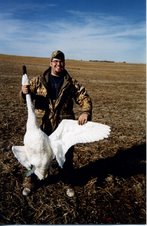
To be honest, it there was a jury full of ducks and geese; I would probably be on death row. The last couple of years I have been lucky enough to hunt waterfowl in several states and Canada each season. In doing so I have hunted with lots of different people using lots of different techniques. Coming home and hunting around my home state of Minnesota using new techniques is challenging and exciting.
I believe that Minnesota waterfowl hunters have more all-around knowledge and hunt harder then hunters from many other states. Minnesota waterfowl hunters must be continually learning and trying new things to be successful. This innovation results in many leading edge products being born in Minnesota.
The short-reed goose call may not have been born in Minnesota, but it certainly has evolved here. Not only is Minnesota home to some of the country’s best goose callers, there are many call-makers that file their taxes within in our great state. The newest call company, Death Row Calls, is quickly making a name for it’s self in the field and on stage.
I imagine that it was a sunny day at the Gamefair when a blonde-haired, younger guy from Thief River Falls stunned a quite audience by winning the 2007 State Goose Calling Championship. I have to imagine because I was not there, but when I heard the news through the grapevine I was excited.
That guy’s name is Cory Loeffler, and for those that know him it should have come as no surprise that he would be crowned state champ. I have known since Cory through calling contests since the fall of 2004. Cory has been collecting plaques and beating this author in calling contests up and down the Red River valley since then.
The thing that surprised me was that Cory won the state championship that day with a call from his new call line, Death Row Calls or DRC for short. Cory had started the new call line in the early part of 2007 and I was impressed by the calls when I first got to try one the second weekend of the ’07 Gamefair.
Not only were the DRC calls displayed on stage during the Gamefair, Cory, being a smart entrepreneur, had a booth at the popular event. When I had the opportunity to congratulate Cory in person, the DRC table was littered with plaques collected by the DRC crew that week. Around the DRC shop in Thief River the guys like to joke that the Death Row Calls line should have gotten an award for being the ‘rookie of the year.’
In it’s first year of existence the Death Row Calls line has won nearly 30 calling competitions. Besides the Minnesota State goose, callers won the North Star Two Man duck and goose with DRC calls. The North Star is a major calling competition held annually in Minnesota, usually at the Gamefair. Competition callers come from all over the country to compete in this event.
I am the kind of waterfowl hunter who likes to wear my passion for the sport all year. At any time you can catch me wearing apparel from various outdoor product manufactures. Another thing Cory has done right is design and print shirts and sweatshirts that are stylish. Believe it or not, goose calling is becoming a Fad with the younger generations.
I would like to end this column with a quick story. Contrary to popular belief, many of us who travel and compete in various calling contests across Minnesota get along very well. I met Cory Loeffler backstage at a calling contest. Although he is mainly a goose caller, once we were both waiting behind the scenes for a duck calling competition. I was surprised when he told me then that it was going to be the first time he had competed at duck calling. We joked around a little and I ended up finishing in second place. Cory says that if you don’t know how to call, you shouldn’t make calls. That day he took first in his first duck calling competition.
If you want to learn more about Death Row Calls feel free to call Cory at the DRC shop 218-686-6617. Or check out www.deathrowcalls.com.

